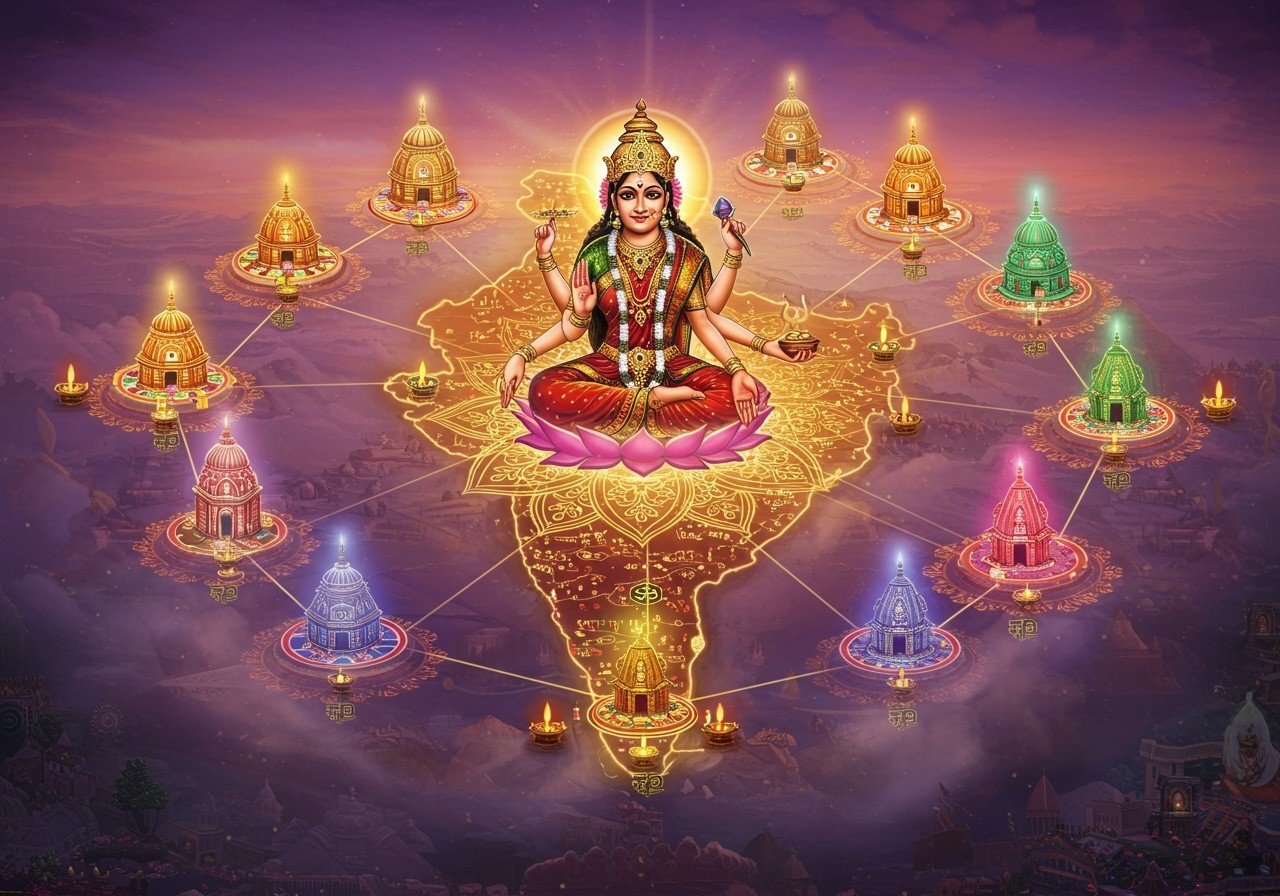
The Shakti Peethas hold deep spiritual and cultural importance in Hinduism. These sacred sites are revered as powerful centers of divine energy and devotion. The concept of 108 Shakti Peethas extends beyond the traditionally recognized 51, offering a wider spiritual landscape. Their origin is linked to the mythology of Goddess Sati and Lord Shiva. Devotees visit these places seeking blessings and spiritual upliftment.
The Mythological Origin of Shakti Peethas
The story begins with Goddess Sati’s self-immolation, a powerful act of protest against her father, King Daksha’s, disrespect towards her husband, Lord Shiva. Consumed by grief and anger, Shiva carried Sati’s body and performed the Tandava, a dance of cosmic proportions. To restore balance, Vishnu used his Sudarshan Chakra to scatter Sati’s body parts across the earth. Each place where a part fell became a Shakti Peetha, imbued with the goddess’s divine energy. While 51 Shakti Peethas are widely acknowledged, the list of 108 encompasses additional sites recognized by different traditions and texts, creating a richer spiritual tapestry. Understanding this distinction helps us appreciate the vastness and depth of these sacred sites within Hindu spirituality.
Exploring the 108 Shakti Peethas
Across the vast spiritual landscape of Hinduism, the Shakti Peethas occupy a truly special place. These sacred shrines, deeply revered as potent centers of divine energy, are each connected to a part of Goddess Sati. The tale of their origin is woven from the poignant threads of Sati’s self-sacrifice and Lord Shiva’s overwhelming sorrow. As Sati’s body parts fell upon the earth, they were transformed into places of profound spiritual power.
The concept of 108 Shakti Peethas broadens the understanding beyond the generally accepted 51. You’ll find mentions of this expanded list in various scriptures, including the Tantras and Puranas, reflecting a diversity of traditions. These sacred sites are not confined to India’s borders; they extend across neighboring countries like Sri Lanka, Pakistan, Nepal, Bangladesh, and even reach the mystical heights of Tibet.
Significance and Worship Practices at the Shakti Peethas
Each Shakti Peetha possesses a unique spiritual identity, associated with a specific deity and a particular part of Sati’s body. West Bengal, for example, is home to several significant sites like Kalighat, Tarapith, and Dakshineswar, each with its own distinctive rituals and traditions. Devotees journey to these holy places with hearts full of hope, seeking divine blessings, spiritual elevation, and the fulfillment of their deepest desires. Pilgrimages to these sacred spots create a beautiful sense of community, bringing worshippers together during festivals and rituals.
The practices observed at these sites vary, reflecting the rich tapestry of Hindu traditions. Some involve elaborate ceremonies, full of symbolism and ancient rites, while others focus on simple offerings and heartfelt prayers. Regardless of the specific rituals, the shared intention is to connect with the divine energy that permeates these holy grounds.
Contemporary Relevance of the 108 Shakti Peethas
Even in today’s fast-paced world, these ancient sites continue to hold deep relevance for those seeking spiritual solace. Many find peace and comfort amidst life’s challenges by visiting these power centers, drawing strength from the divine energy they radiate. The rise of online platforms has made information about these sacred sites more accessible than ever. Virtual tours and online resources provide a wonderful way for devotees to connect with their spiritual heritage, regardless of their location.
The increase in tourism presents both opportunities and challenges. While it helps to preserve and maintain these ancient treasures, it also requires a delicate balance between maintaining the sanctity of the space and providing modern conveniences. Continuous efforts are being made to ensure that the spiritual essence of these sacred places remains undisturbed for generations to come.
Cultural and Spiritual Impact of Shakti Peethas
The influence of the Shakti Peethas stretches beyond religious practices, deeply enriching the cultural fabric of the regions where they are located. They inspire local folklore, artistic expressions, and literary works, weaving themselves into the very essence of these communities. Stories associated with these sacred sites have been passed down through countless generations, enriching the cultural tapestry.
Many devotees share deeply personal stories of transformation following their visits to Shakti Peethas. These powerful narratives illuminate the enduring spiritual teachings and philosophies that continue to resonate with believers today. Pilgrimages often spark profound personal insights and a deeper connection with the divine.
How Poojn Helps You Connect with Shakti Peethas
Poojn.in offers a wide selection of essential puja items and resources to help devotees maintain their spiritual connection with the divine Shakti Peethas. Our thoughtfully curated collection includes:
- Authentic puja samagri for worshipping Maa Kali, Maa Durga, and other revered forms of the Divine Mother. We understand the importance of using genuine items in your spiritual practices.
- Pure copper and brass items ideal for temple offerings and home altars. These materials are traditionally believed to enhance the sanctity of rituals.
- Traditional bell metal products used in Shakti Peeth rituals, adding an authentic touch to your worship.
- Natural incense sticks and dhoop for creating a sacred atmosphere during ceremonies. Our selection includes a variety of fragrances to suit your preferences.
- Pure cotton wicks and ghee for aarti, essential components of many Hindu rituals.
- Vermillion (sindoor) and other ritual items specifically used in Shakti worship. We source these items with utmost care to ensure their authenticity.
We deliver these sacred items right to your doorstep anywhere in India. Our dedicated team meticulously verifies the authenticity and quality of each product, ensuring they meet traditional standards for worship. For personalized guidance on selecting the appropriate puja items for specific Shakti Peeth rituals, feel free to reach out to us:
- Call us at 03369029784
- Message us on WhatsApp: 9476142738
- Visit www.poojn.in to explore our complete collection
All products are carefully packaged to maintain their purity during transit. We also provide clear instructions for the proper use and storage of these ritual items.
Shop Devi Puja Items
View Aarti Essentials
Buy Vaijanti Mala
Buy Dakshina Maa Kali Murti
Embracing the Sacred Journey
The 108 Shakti Peethas beckon us on a profound journey, one that transcends the boundaries of time and space, weaving through the spiritual heart of India and beyond. They stand as radiant beacons of divine energy, guiding devotees towards a deeper understanding and a stronger connection with the divine. By exploring these sacred sites, whether physically or virtually, we honor the rich traditions and captivating stories that shape our cultural identity.
As we embark on this sacred journey, we connect with the eternal legacy of Goddess Sati and Lord Shiva, drawing inspiration and finding solace in their divine story. The Shakti Peethas offer a timeless link to our spiritual roots, reminding us of the immense power and grace that dwell within these holy places.
FAQs on Beyond the 51: Understanding the 108 Shakti Peethas
What are the 108 Shakti Peethas?
The 108 Shakti Peethas are revered sites in Shaktism, dedicated to the goddess Shakti, where parts of Sati’s body are believed to have fallen, each radiating unique divine energy.
Are there really 108 Shakti Peethas?
While the 51 Shakti Peethas are more commonly known, various scriptures and traditions recognize 108, expanding the spiritual geography of these sacred locations.
Where can I find the 108 Shakti Peethas?
These sacred sites are spread across the Indian subcontinent and beyond, including countries like India, Nepal, Bangladesh, Pakistan, Sri Lanka, and even Tibet, each holding a piece of Sati’s divine essence.
Why are the Shakti Peethas important?
Shakti Peethas are deeply significant in Hinduism, representing the divine feminine power (Shakti). They are places of pilgrimage where devotees seek blessings, spiritual awakening, and connection with the goddess.
How did the legend of the Shakti Peethas begin?
The legend originates from the story of Sati’s self-immolation and Shiva’s subsequent Tandava. As Shiva carried Sati’s body, parts fell to earth, becoming energized with Shakti’s divine essence, thus forming the Shakti Peethas.
What rituals are performed at Shakti Peethas?
Rituals vary depending on the specific Shakti Peetha but often include pujas, prayers, offerings, and participation in festivals honoring the goddess, reflecting local customs and traditions.
Can I visit all 108 Shakti Peethas?
Visiting all 108 Shakti Peethas is a significant undertaking, a pilgrimage of immense spiritual significance. While challenging, many devotees aspire to complete this journey for profound spiritual fulfillment. Those unable to visit all can still connect deeply with these sacred sites through prayer, study, and virtual exploration.


